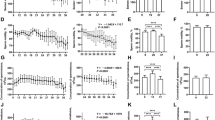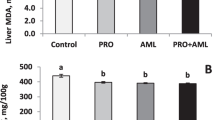Abstract
The paper aims to compare parameters of lipid peroxidation and antioxidant defense system, as well as blood biochemical composition in infertile cows from groups that differ in terms of selenium content in agrocoenosis. Forty-five black-motley and red-motley breeds in each region were selected for the experiment; the groups were formed on the basis of the pathology, 15 animals each. The level of microelements in the blood of animals from all groups in the selenium-deficient biogeochemical province is significantly reduced by 38.4–41.7% (P < 0.05). In these cows, the concentration of malondialdehyde increased significantly, by 1.5–2.1 times (P < 0.05), against the background of decrease in the activity of glutathione antioxidant defense: glutathione peroxidase by 9.4–32.1% (P < 0.05), glutathione reductase by 2.4–2.6 times (P < 0.05), also superoxide dismutase and catalase in some groups. In the groups of infertile animals with lowered selenium content in blood, the author found an increase in enzymes’ activity (P < 0.05): alanine aminotransferase by 25.6–52.6%, aspartate aminotransferase by 17.8% in cysts and by 44.3% in ovarian hypofunction, gamma-glutamyltransferase by 18.3% in ovarian hypofunction. In addition, the calcium content in the blood of cows was reduced by 8.1–14.0% (P < 0.05) when selenium levels were lowered. In combination with elevated levels of urea and urea/creatinine ratio, the above may be evidence of pathological processes in muscle, liver, and kidney tissues. Thus, the author traced the dependence of the balance of lipid peroxidation and antioxidant defense system on the microelement level, as well as the effect of low selenium provision of animals in biogeochemical provinces on the biochemical composition of their blood.


Similar content being viewed by others
Data Availability
Data will be available on request.
Code Availability
Code will be available on request.
References
Pavlata L, Illek J, Pechova A, Matejicek M (2002) Selenium status of cattle in the Czech Republic. Acta Vet Brno 71:3–8. https://doi.org/10.2754/avb200271010003
Yasothai R (2014) Importance of minerals on reproduction in dairy cattle. Int J Sci Environ Technol 3(6):2051–2057
Haruta GG, Volkov SS, Podvalyuk DV, Vlasenko SA, Ordin YN, Ivasenko BP, Lototsky VV (2011) Veterinary support for intensive reproduction of cattle. Proc Orenburg State Agrarian Univ 2(20):85–87
Safonov VA (2008) On the metabolic profile of highly productive cows during pregnancy and infertility. Agric Biol 43(4):64–67
Sokolova OV, Shkuratova IA, Ryaposova MV (2015) Clinical and biochemical profile and reproductive function of cows in iodine deficiency regions. Reprod Domest Anim 50(3):77–78
Nikitin G, Plemyashov K, Nikitina A, Anipchenko P, Nechaev A, Korochkina E, Ladanova M, Lobodenko N, Bazhenova N, Shabunin SV (2019) Evaluation of progesterone measurement for the diagnosis pregnancy and embryonic mortality in dairy cows. Reprod Domest Anim 54(S3):136
Gavrilenko NN (2019) Operational infertility of cows. Sci Notes Kazan State Acad Vet Med N E Bauman 240(4):41–47
Bagmanov MA, Yusupov SR, Mavlikhanov PF, Hismutdinov AG (2015) Infertility and pathology of the mammary gland in cows of livestock enterprises of the Republic of Tatarstan. Sci Notes Kazan State Acad Vet Med N E Bauman 221(1):26–29
Roth Z, Biran D, Lavon Y, Dafni I, Yakobi S, Braw-Tal R (2012) Endocrine milieu and developmental dynamics of ovarian cysts and persistent follicles in postpartum dairy cows. J Dairy Sci 95(4):1729–1737. https://doi.org/10.3168/jds.2011-4513
Giadinis ND, Loukopoulos P, Petridou EJ, Panousis N, Konstantoudaki K, Filioussis G, Tsousis G, Brozos C, Koutsoumpas AT, Chaintoutis SC, Karatzias H (2016) Abortions in three beef cattle herds attributed to selenium deficiency. Pak Vet J 36:145–148
Chen CJ, Xiao P, Chen Y, Fang R (2019) Selenium deficiency affects uterine smooth muscle contraction through regulation of the RhoA/ROCK signalling pathway in mice. Biol Trace Elem Res 192(2):277–286. https://doi.org/10.1007/s12011-019-01677-8
Kommisrud E, Østerås O, Vatn T (2005) Blood selenium associated with health and fertility in Norwegian dairy herds. Acta Vet Scand 46(4):229–240. https://doi.org/10.1186/1751-0147-46-229
Rassolov SN, Eranov AM, Zubova TV (2009) Effect of the drug E-selen on reproductive function of cows. Siberian Bull Agric Sci 7(199):113–166
Sevostyanova OI, Orobets VA, Agarkov AV, Fedota NV, Klimanovich I (2020) Aggregate-resistant vitamin-mineral complex based on selenium; comparative effectiveness in poultry farming against the technological stress. Int J Vet Sci 9(1):141–144
Karpenko LY, Enukashvili AI, Bakhta A (2011) The dynamics of nonspecific resistance in cattle depending on the physiological state. Med Immunol 13(4–5):547
Nezhdanov AG, Shabunin SV, Safonov VA (2014) Selenium and reproductive health of animals. Veterinary 5:4–8
Serebritsky MV (2018) Selenium and prevention of reproductive diseases in cows. In: Ecological and biological problems of natural resources in agriculture, vol 1. Proceedings of the IV International Scientific and Practical Conference of Young Scientists and Specialists. Yekaterinburg, pp 266–270
Shkuratova IA, Ryaposova MV (2011) Gynecological pathology in cows in breeding farms with tethered and untethered housing technology. Kuban Vet 4:21–23
Vasilyeva SV (2011) Influence of the vitamin and mineral complex on the antioxidant status of dry cows. In: Proceedings of the III Congress of pharmacologists and toxicologists of Russia: Actual problems of veterinary pharmacology, toxicology and pharmacy. SPb., 19–22 May, pp 92–94
Ventsova I, Safonov V (2021) The role of oxidative stress during pregnancy on obstetric pathology development in high-yielding dairy cows. Am J Anim Vet Sci 16(1):7–14
Witchel JJ, Keefe GP, Van Leeuwen JA, Spangler E, McNiven MA, Ogilvie TH (2004) The selenium status of dairy herds in Prince Edward Island. Canad Vet J 45(2):124–132
Mehdi Y, Hornick JL, Istasse L, Dufrasne I (2013) Selenium in the environment, metabolism and involvement in body functions. Molecules 18(3):3292–3311. https://doi.org/10.3390/molecules18033292
Baroboi VA (2001) Biological functions, metabolism and mechanism of action of selenium. Usp Sovremen Biol 121(2):157–158
Xu J, Gong Y, Sun Y, Cai J, Liu Q, Bao J, Yang J, Zhang Z (2020) Impact of selenium deficiency on inflammation, oxidative stress, and phagocytosis in mouse macrophages. Biol Trace Elem Res 194(1):237–243. https://doi.org/10.1007/s12011-019-01775-7
Cheryl L, Blackley B (2014) Evaluating micronutrient concentrations in liver samples from abortions, stillbirths, and neonatal and postnatal losses in beef calves. J Vet Diagn Invest 26(3):376–389. https://doi.org/10.1177/1040638714526597
Aschenbrenner AI, Khapersky VA (2020) Biochemical blood parameters of high-yielding cows in the joint course of hypocalcemia and hypophosphatemia. In: Chebotaev AN (ed) Agrarian science - agriculture. Collection of Materials of the XV International Scientific-Practical Conference in 2 volumes. ASAU, Barnaul, pp 280–282
Haug A, Graham RD, Christophersen OA, Lyons GH (2007) How to use the world’s scarce selenium resources efficiently to increase the selenium concentration in food. Microb Ecol Health Dis 19(4):209–228
Rylnikova MV, Radchenko DN, Tsupkina MV, Safonov VA (2020) Study of the environmental impact of Novotroitsk tailings pond on vegetation and living organisms. Proc Tula State Univ Earth Sci 1:108–120
Safonov VA (2018) Biological role of selenium and correction of its content in the organism of animals. Geochem Int 56(10):1046–1050
Malyshev IY, Manukhina EB (2000) Stress-limiting nitric oxide system. Russ Physiol J 86(10):1283–1292
Turk R, Samardžija M, Bačić G (2011) Oxidative stress and reproductive disorders in dairy cows. In: Marek ER (ed) Dairy cows: nutrition, fertility and milk production. Nova Science Publishers, New York, USA, pp 57–98
Surai PF, Kochish II, Fisinin VI, Juniper DT (2019) Revisiting oxidative stress and the use of organic selenium in dairy cow nutrition. Animals 9(7):462. https://doi.org/10.3390/ani9070462
Safonov VA, Nezhdanov AG, Retsky MI, Shabunin SV, Bliznetsova GN (2014) Free radical lipid oxidation and reproductive health of cows. Agricultural Biology 49(6):107–115. https://doi.org/10.15389/agrobiology.2014.6.107eng
Sookoian S, Pirola CJ (2015) Liver enzymes, metabolomics and genome-wide association studies: from systems biology to the personalized medicine. World J Gastroenterol 21(3):711–725. https://doi.org/10.3748/wjg.v21.i3.711
Yeremenko VI, Buntseva EG (2012) Dynamics of aminotransferases, total protein and thyroid function in cows with different milk productivity. Bull Kursk State Agric Acad 6:62–64
Nezhdanov AG, Retskii MI, Alekhin YN, Safonov VA, Shushlebin VI, Papin NE, Brekhov TP, Shishkina EV (2010) Cliniko-hematologic and biochemical status of cows at gestosis. Agric Biol 45(4):118–123
Funding
This research did not receive any specific grant from funding agencies in the public, commercial, or not-for-profit sectors.
Author information
Authors and Affiliations
Contributions
Vladimir Safonov is the single author and he is the only one responsible to the content of the manuscript.
Corresponding author
Ethics declarations
Ethics Approval and Consent to Participate
All animal handling conformed to the humane treatment requirements for laboratory animals set out in Directive 2010/63/EC. The study was conducted in accordance with the ethical principles approved by the Ethics Committee of Vernadsky Institute of Geochemistry and Analytical Chemistry (Protocol № 2 of 14.03.2020).
Consent for Publication
Informed consent for publication of the data was obtained from the owners of the farms located in the Voronezh and Kirov region.
Conflict of Interest
This research has no conflict of interests.
Additional information
Publisher's Note
Springer Nature remains neutral with regard to jurisdictional claims in published maps and institutional affiliations.
Rights and permissions
About this article
Cite this article
Safonov, V. Comparison of LPO-AOS Indices and Biochemical Composition of Animal Blood in Biogeochemical Provinces with Different Levels of Selenium . Biol Trace Elem Res 200, 2055–2061 (2022). https://doi.org/10.1007/s12011-021-02825-9
Received:
Accepted:
Published:
Issue Date:
DOI: https://doi.org/10.1007/s12011-021-02825-9




